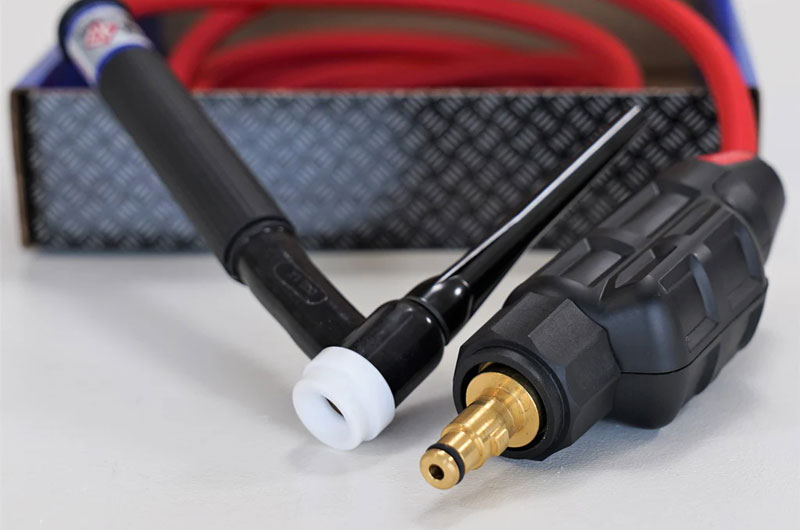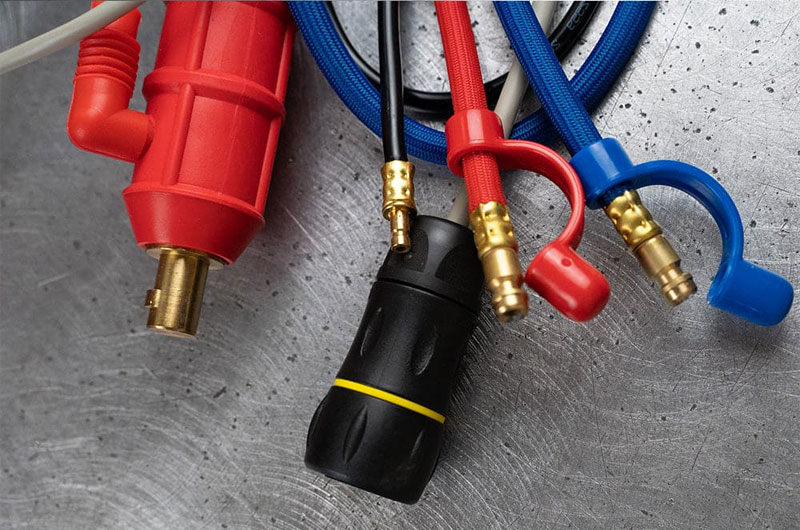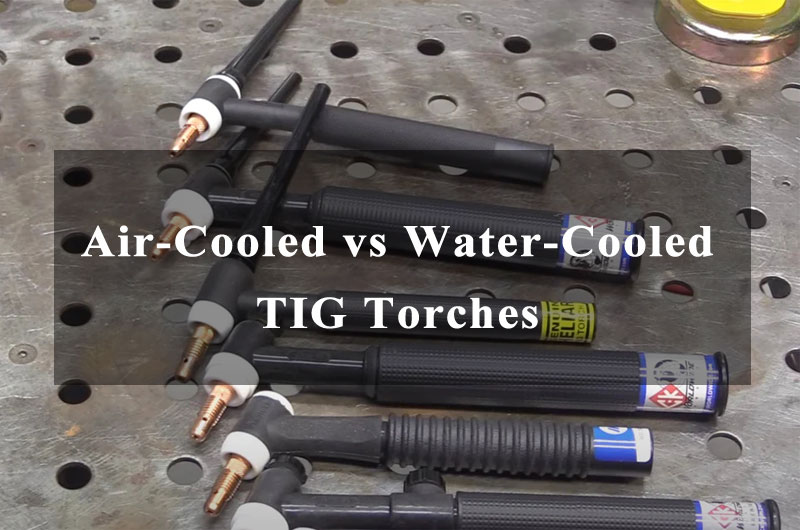Selecting the right TIG (GTAW) torch cooling system is crucial for welders who demand consistent arc performance, operator comfort, and long-term equipment reliability.
TIG torches are typically available in two cooling configurations: air-cooled and water-cooled, each offering distinct advantages and trade-offs.
This article examines the principles behind each system, compares their performance characteristics, and provides guidance on choosing the best torch for your specific welding applications.
How TIG Torches Are Cooled
TIG torches generate considerable heat at the tungsten electrode and collet body during welding. Effective cooling prevents overheating, which can degrade consumables, damage torch components, and increase operator fatigue.
- Air-Cooled Torches rely on natural convection and forced airflow (via the gas flow) to dissipate heat from the torch head and handle.
- Water-Cooled Torches circulate a coolant (typically water or a water-glycol mixture) through channels in the torch body and head, actively removing heat before it can accumulate.
Air-Cooled TIG Torches

Air-cooled torches depend on the shielding gas flow—argon or argon mixtures—that passes through the torch body to carry heat away. In addition, the torch’s aluminum or fiberglass handle and torch head are designed with fins or vents to increase surface area and promote heat dispersion.
Advantages
- Simplicity and Portability: Without hoses or a separate cooling unit, air-cooled torches are lighter and easier to maneuver—ideal for overhead or tight-space work.
- Lower Initial Cost: Air-cooled torches and related consumables are generally less expensive than their water-cooled counterparts.
- Minimal Maintenance: Fewer components (no coolant pump, reservoir, or flow regulators) mean fewer potential failure points and lower ongoing maintenance.
Limitations
- Heat Build-Up in Heavy Duty Use: At higher amperages (typically above 200–250 A), air-cooled torches can become uncomfortably hot for the operator and may require frequent cool-down breaks.
- Consumable Lifespan: Elevated torch-head temperatures accelerate wear on collets, cups, and the tungsten electrode itself, increasing consumable costs.
- Duty Cycle Constraints: Manufacturers often rate air-cooled torches for lower duty cycles compared to water-cooled units, limiting continuous high-amperage welding.
Water-Cooled TIG Torches

Water-cooled torches incorporate internal tubing that circulates coolant from an external chiller or welding power source with built-in cooling. The coolant absorbs heat from the torch head and electrode assembly, then returns to the chiller to be cooled and recirculated.
Advantages
- Superior Heat Management: Water cooling efficiently removes heat even at high amperages (300 A and above), keeping the torch head and handle cool to the touch.
- Extended Duty Cycles: Water-cooled systems allow continuous welding for extended periods without overheating, improving productivity in heavy-duty industrial settings.
- Longer Consumable Life: Maintaining lower head temperatures slows wear on collets, nozzles, and electrodes, reducing replacement frequency and cost over time.
Limitations
- Complexity and Setup: Requires a coolant source (chiller or power source with integrated cooler), hoses, and fittings. Setup and breakdown take longer, and there’s added weight from the water lines.
- Higher Initial Investment: The torches themselves cost more, and so does the associated cooling equipment.
- Maintenance Requirements: Coolant must be monitored for level and quality, the system needs periodic flushing, and pumps or chillers require servicing.
Head-to-Head Comparison
| Feature | Air-Cooled | Water-Cooled |
|---|---|---|
| Amperage Range | Up to ~200–250 A | Up to 400 A and beyond |
| Weight & Maneuverability | Lightweight, highly portable | Heavier hoses, less portable |
| Duty Cycle | Lower duty cycle | High continuous duty cycle |
| Consumable Wear | Faster wear at high heat | Slower wear with consistent cooling |
| Setup Complexity | Plug-and-play | Requires chiller/setup |
| Cost | Lower initial cost | Higher initial and maintenance costs |
| Maintenance | Minimal | Regular coolant checks and servicing |
Choosing the Right Torch for Your Application
- Light Fabrication & Maintenance Work
- Typically involves intermittent welding at amperages below 200 A.
- Recommendation: Air-cooled torch for quick setup and easy handling.
- Heavy Industrial & Production Welding
- Continuous high-amperage welding (200 A+) in manufacturing, shipbuilding, or aerospace.
- Recommendation: Water-cooled torch to maintain cool temperatures, maximize duty cycle, and minimize consumable consumption.
- Field Service & Mobile Welding
- Work in remote locations or confined spaces demanding high portability.
- Recommendation: Air-cooled torch, unless sustained high-amp welding is required—then consider portable chillers.
- Precision or Long-Duration Welding
- Projects requiring long, uninterrupted welds for precision or aesthetics.
- Recommendation: Water-cooled torch to ensure arc stability and operator comfort.
Maintenance and Safety Considerations
- Air-Cooled Torches:
- Regularly inspect vents or fins to ensure they are clear of debris.
- Replace consumables proactively to avoid heat spikes that could damage the torch.
- Water-Cooled Torches:
- Use distilled or deionized water mixed with corrosion inhibitors to prevent scaling and bacterial growth.
- Check hoses and fittings for leaks; a water leak into the torch head can cause short circuits or damage to the welding machine.
- Drain and flush the system according to manufacturer recommendations, typically every 3–6 months.
- General Safety:
- Always wear appropriate PPE, including heat-resistant gloves and face protection.
- Ensure proper grounding of both the torch and cooling unit.
- Train operators on the specific quirks of each system—overheating in air-cooled torches or coolant handling for water-cooled units.

